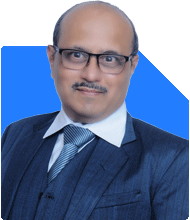48-year-old with 23 crores in real estate, how to invest for retirement?
Ramalingam Kalirajan |9640 Answers |Ask -Follow
Mutual Funds, Financial Planning Expert - Answered on Sep 30, 2024
He has an MBA in finance from the University of Madras and is a certified financial planner.
He is the director and chief financial planner at Holistic Investment, a Chennai-based firm that offers financial planning and wealth management advice.... more

Hi, I'm 48 ..I'm thinking about my retirement now. My son is 13 while we both (wife and self) are employed with a cashflow of 7.5lacs per month including rental (3lacs) income). My current Investment spread is Real Estate (various- 23Crs.)/ PPF 1.10crs./ NPS 10lacs/ MF 10lacs with 70k per month monthly outflow and liabilities of 2crs. My likely expenses are Higher Education/Marriage and Retirement Corpus. How should I spread my investments to cover my Salary loss, post-retirement?
Given your current financial standing, let's break down how to optimise your investments for post-retirement expenses, covering your son's higher education, his marriage, and ensuring a comfortable retirement corpus.
Assessing Future Needs
You will likely have significant financial requirements for higher education and marriage, alongside securing a post-retirement lifestyle. Let’s break these down into specific objectives:
Higher Education: Your son is 13, and you will likely need funds for his higher education in the next 4-5 years. Assuming that you will need funds for both domestic and international education, you should plan for a sizeable education fund.
Marriage: You will also want to earmark funds for your son's marriage, possibly 10-15 years from now.
Retirement Corpus: Post-retirement, your current income of Rs 7.5 lakh will no longer be available, except for the Rs 3 lakh in rental income. You will need a retirement corpus that ensures you can maintain your lifestyle comfortably.
Understanding Current Investments
1. Real Estate (Rs 23 crore)
You have substantial assets in real estate, which is excellent for wealth preservation. However, real estate can be illiquid, and income from it may fluctuate based on market conditions.
Real estate should not be the only major asset class for retirement, as it lacks liquidity and is affected by local markets. Diversifying beyond real estate will help balance your portfolio.
2. PPF (Rs 1.10 crore)
Your PPF investment provides safety and tax-free returns. However, PPF has a limited ability to grow aggressively and keep pace with inflation in the long term.
You should continue contributing to PPF, as it offers guaranteed returns with tax benefits, but it may not be enough on its own to meet all your goals.
3. NPS (Rs 10 lakh)
NPS is a good tool for retirement savings as it provides a mix of equity and debt. Given your age and the time left until retirement, you can maximise the equity exposure within your NPS to boost growth.
However, NPS has liquidity constraints, so you cannot rely entirely on it for immediate cash needs.
4. Mutual Funds (Rs 10 lakh and SIP of Rs 70,000 per month)
Your mutual funds provide an avenue for growth. A monthly SIP of Rs 70,000 is a good strategy for long-term wealth creation.
Ensure your mutual fund portfolio is diversified across equity and debt, with a focus on equity for growth. As you approach retirement, gradually increase debt exposure for stability.
Addressing Liabilities (Rs 2 crore)
Liabilities of Rs 2 crore need to be addressed systematically to ensure they do not impact your retirement plan. If these are loans or mortgages, you can either work on reducing them or look for ways to generate consistent income from your real estate investments to cover these liabilities. It’s important not to let liabilities grow as you approach retirement, as they can reduce your financial flexibility.
Creating a Strategy for Retirement, Education, and Marriage
1. Retirement Corpus Planning
Since you will continue to receive Rs 3 lakh in rental income, you will only need to replace the remaining Rs 4.5 lakh per month of lost salary post-retirement. Considering inflation, this amount will increase significantly over time.
You may need to build a retirement corpus of Rs 10-12 crore to comfortably replace your current salary and cover inflation-adjusted expenses post-retirement.
Ensure your investment portfolio has a mix of equity, debt, and real estate to manage risks and returns. For retirement, start creating a well-diversified mutual fund portfolio that includes both growth-oriented funds (equity) and safety nets (debt funds).
2. Higher Education Planning
In 4-5 years, you will need funds for your son's higher education. This will likely be a substantial expense, especially if you plan for international education.
Create a separate education fund. This fund can be composed of a mix of equity mutual funds (for growth) and debt funds (for stability). Given the short time horizon, a mix of 60% equity and 40% debt would provide good growth while limiting volatility. You could start with a lump-sum investment now or increase your SIP contributions toward this goal.
3. Marriage Fund
Planning for your son’s marriage 10-15 years down the line will require a separate investment strategy. You can create a long-term marriage fund focused on high-growth equity funds since you have a long time horizon.
Continue investing in equity mutual funds, aiming for a corpus of Rs 50 lakh to Rs 1 crore, depending on your expectations for marriage expenses. Consider step-up SIPs, which will allow you to gradually increase your investment amount over time to keep pace with inflation.
Optimising Your Existing Portfolio
1. Real Estate
Real estate is a large portion of your portfolio, but as you approach retirement, consider reducing your dependency on it. You don’t need to sell immediately, but you can start converting some of your real estate investments into more liquid assets, like mutual funds or bonds, over the next few years. This will give you flexibility in retirement.
2. PPF and NPS
Continue investing in PPF, as it offers guaranteed and tax-free returns. However, it will form a conservative part of your portfolio, so focus on diversifying into other asset classes like mutual funds for growth.
Increase your contributions to NPS if possible, as it’s a tax-efficient way to save for retirement. Maximise the equity portion of your NPS to ensure better returns.
3. Mutual Funds
Your current SIP of Rs 70,000 is a good start, but given your income, you could increase it to Rs 1 lakh or more. This will help accelerate your retirement corpus accumulation. A well-diversified portfolio with a mix of large-cap, mid-cap, and multi-cap funds will ensure balanced growth.
You can also start a separate SIP for your son’s education fund. Focus on a mix of equity and debt to balance growth with safety, especially since you’ll need the funds in 4-5 years.
Managing Liabilities
It’s important to focus on paying down your Rs 2 crore liabilities as you approach retirement. If these are loans or mortgages, plan to clear them over the next few years to reduce the financial burden.
Use a portion of your rental income to service these liabilities without affecting your lifestyle or savings.
Final Insights
Retirement Corpus: Aim for Rs 10-12 crore to comfortably replace your income and cover inflation.
Higher Education: Plan for a corpus of Rs 50 lakh to Rs 1 crore for your son’s education.
Marriage Fund: Start building a long-term marriage fund, aiming for Rs 50 lakh to Rs 1 crore.
SIP Strategy: Increase your SIP to Rs 1 lakh per month or more to meet your goals faster.
Debt Management: Focus on clearing your Rs 2 crore liabilities over the next few years.
By following this approach, you can ensure a comfortable retirement, cover your son's education and marriage expenses, and secure your financial future.
Best Regards,
K. Ramalingam, MBA, CFP,
Chief Financial Planner,
www.holisticinvestment.in
https://www.youtube.com/@HolisticInvestment
You may like to see similar questions and answers below
Ramalingam Kalirajan |9640 Answers |Ask -Follow
Mutual Funds, Financial Planning Expert - Answered on May 12, 2024
Ramalingam Kalirajan |9640 Answers |Ask -Follow
Mutual Funds, Financial Planning Expert - Answered on Jun 22, 2024
Ramalingam Kalirajan |9640 Answers |Ask -Follow
Mutual Funds, Financial Planning Expert - Answered on Jun 29, 2024
Ramalingam Kalirajan |9640 Answers |Ask -Follow
Mutual Funds, Financial Planning Expert - Answered on Oct 08, 2024
Nitin Narkhede |87 Answers |Ask -Follow
MF, PF Expert - Answered on Oct 25, 2024
Ramalingam Kalirajan |9640 Answers |Ask -Follow
Mutual Funds, Financial Planning Expert - Answered on Jul 10, 2025
Ramalingam Kalirajan |9640 Answers |Ask -Follow
Mutual Funds, Financial Planning Expert - Answered on Jul 10, 2025
Ramalingam Kalirajan |9640 Answers |Ask -Follow
Mutual Funds, Financial Planning Expert - Answered on Jul 10, 2025
Ramalingam Kalirajan |9640 Answers |Ask -Follow
Mutual Funds, Financial Planning Expert - Answered on Jul 10, 2025
Nayagam P P |8447 Answers |Ask -Follow
Career Counsellor - Answered on Jul 10, 2025
Nayagam P P |8447 Answers |Ask -Follow
Career Counsellor - Answered on Jul 10, 2025
Nayagam P P |8447 Answers |Ask -Follow
Career Counsellor - Answered on Jul 10, 2025
Ramalingam Kalirajan |9640 Answers |Ask -Follow
Mutual Funds, Financial Planning Expert - Answered on Jul 10, 2025
Ramalingam Kalirajan |9640 Answers |Ask -Follow
Mutual Funds, Financial Planning Expert - Answered on Jul 10, 2025
Ramalingam Kalirajan |9640 Answers |Ask -Follow
Mutual Funds, Financial Planning Expert - Answered on Jul 10, 2025



















